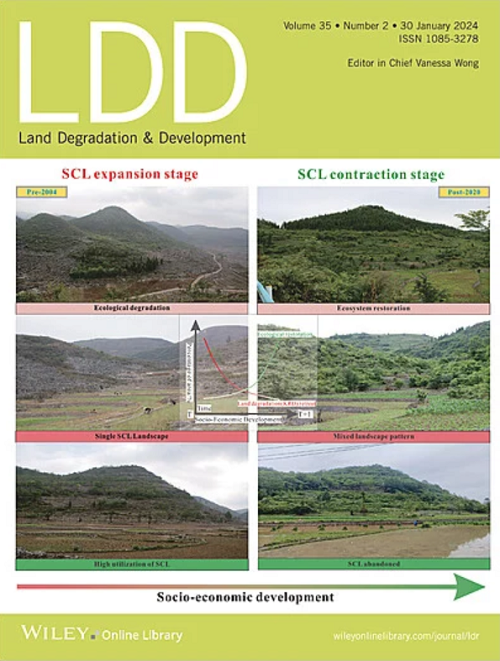Can Organic Matter in Brownfield Soils Reach the Same Level and Quality as in Natural Soils in the Same Area? Study of Soils Long-Term Contaminated With Trace Metals Under Moderate Climate Conditions in Poland
IF 3.6
2区 农林科学
Q2 ENVIRONMENTAL SCIENCES
引用次数: 0
Abstract
We investigated whether old, self-restored brownfield soils could store similar amounts of soil organic matter (SOM) to natural, reference soils, which would make them valuable for the environment in the fight against global warming. The brownfield soils came from heaps formed after Zn/Pb ore, coal extraction and from the environs of an Fe-smelter. They differed in age (50–400 years); all were covered with grass. We examined: soil pH, texture, enzyme activity, and C, N, P, K, CaCO3 contents, Zn, Pb and Cd contamination of soils and grasses and biomass, lignin, Ca, K, P, Na contents of grasses. SOM stabilisation was evaluated through the analysis of the humic acids (HAs) composition and optical properties. In all soils, the mean C stocks ranged from 5.8 to 10.3 kg/m2 and were similar to these in the reference soils, but the HAs of the brownfield soils had a more aliphatic structure and lower maturity, thus less stabilised SOM than the reference soils. High C accumulation in brownfield soils resulted from the high biomass, especially roots, of the well-adapted plants covering these soils, which were also rich in lignin, accumulated as a protection against stress. A lower SOM stabilisation of brownfield soils than of reference ones was caused by their high TMs contamination, but it differed according to the combined effects of both: the soil age (being more stabilised in older soils) and a disturbance degree (more stabilised in less disturbed industrial soils than mine ones).棕地土壤的有机质能达到同地区自然土壤的水平和质量吗?波兰温和气候条件下土壤长期受微量金属污染的研究
我们调查了旧的、自我修复的棕地土壤是否能储存与自然的、参考土壤相似的土壤有机质(SOM),这将使它们在对抗全球变暖的环境中具有价值。棕地土壤来自锌/铅矿石、煤炭开采后形成的堆,以及一家铁冶炼厂的周边地区。他们年龄不同(50-400岁);所有的地方都长满了草。我们检测了土壤pH、质地、酶活性以及土壤和牧草的C、N、P、K、CaCO3含量、Zn、Pb和Cd污染以及生物量、木质素、Ca、K、P、Na含量。通过分析腐植酸(HAs)的组成和光学性质来评价SOM的稳定性。在所有土壤中,平均碳储量在5.8 ~ 10.3 kg/m2之间,与对照土壤相似,但棕地土壤的HAs具有更多的脂肪族结构和较低的成熟度,因此比对照土壤更不稳定的SOM。棕地土壤的高碳积累是由于覆盖在这些土壤上的适应良好的植物的高生物量,特别是根系,它们也富含木质素,积累了作为抵抗胁迫的保护。棕地土壤的SOM稳定性低于参考土壤,这是由于它们的高TMs污染造成的,但它根据两者的综合影响而有所不同:土壤年龄(在较老的土壤中更稳定)和干扰程度(在受干扰较少的工业土壤中比矿山土壤更稳定)。
本文章由计算机程序翻译,如有差异,请以英文原文为准。
求助全文
约1分钟内获得全文
求助全文
来源期刊

Land Degradation & Development
农林科学-环境科学
CiteScore
7.70
自引率
8.50%
发文量
379
审稿时长
5.5 months
期刊介绍:
Land Degradation & Development is an international journal which seeks to promote rational study of the recognition, monitoring, control and rehabilitation of degradation in terrestrial environments. The journal focuses on:
- what land degradation is;
- what causes land degradation;
- the impacts of land degradation
- the scale of land degradation;
- the history, current status or future trends of land degradation;
- avoidance, mitigation and control of land degradation;
- remedial actions to rehabilitate or restore degraded land;
- sustainable land management.
 求助内容:
求助内容: 应助结果提醒方式:
应助结果提醒方式:


